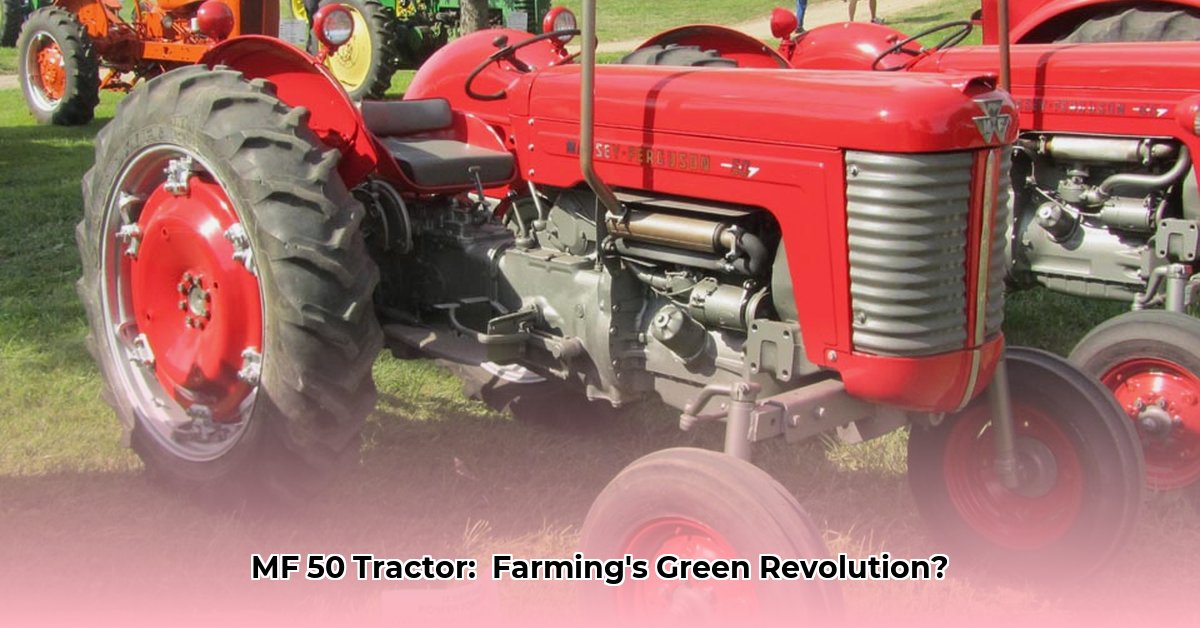
Massey Ferguson 50 Tractor: A Legacy of Progress and its Environmental Footprint
The Massey Ferguson 50 tractor, a ubiquitous sight in fields across the globe during the late 1950s and early 1960s, wasn't merely a machine; it represented a pivotal shift in agricultural practices. This robust tractor, boasting a 32-38 horsepower engine, dramatically altered the landscape of farming, impacting both productivity and the environment in profound and complex ways. Its story is one of both progress and unintended consequences, a narrative that continues to resonate in contemporary discussions about sustainable agriculture. For more on classic farm tractor brands, see this helpful resource.
The MF 50: A Technological Revolution in the Fields
Prior to the widespread adoption of the MF 50, farming was predominantly a labor-intensive undertaking. The introduction of this powerful and reliable tractor was transformative. Farmers could cultivate larger areas, complete tasks more swiftly, and ultimately produce significantly more food. The MF 50’s versatility further amplified its impact. Farmers had a choice of engines: diesel, gasoline, or even liquid propane gas, providing flexibility based on individual needs and economic considerations. This adaptability represented a major leap forward in the customization of farm machinery. How did this immediate increase in efficiency impact agricultural practices in the long term? This is a key question we will explore.
The economic consequences were immediate and far-reaching. Labor costs decreased dramatically, freeing up resources and boosting profits for many. However, this newfound efficiency also raises crucial questions about its long-term sustainability.
The Environmental Footprint: A Necessary Consideration
While the MF 50 undeniably revolutionized productivity, we must directly address its environmental impact. Precise fuel consumption and emissions data for the MF 50 are scarce, but it's clear that compared to modern tractors, its fuel efficiency was substantially lower, and its emissions considerably higher. This discrepancy underscores the evolving understanding of the delicate balance between increased production and environmental responsibility—a tension that remains at the heart of contemporary sustainable agriculture. This isn't to cast the MF 50 as inherently environmentally damaging; rather, it reflects the technological constraints of its era. Its legacy must be viewed within the broader historical context of agricultural innovation, where the pursuit of efficiency often necessitated trade-offs in environmental protection. Does this mean that the positive impacts of the MF50 outweighed the negative?
Reshaping Farming Practices: Bigger Farms, Bigger Questions
The MF 50’s influence transcended the individual farm level. Its enhanced efficiency made large-scale farming economically viable, fostering a trend towards consolidation. Smaller, family-run farms, reliant on manual labor, found themselves increasingly struggling to compete with the economies of scale enjoyed by their larger counterparts. This consolidation, while boosting productivity for some, sparked concerns about the long-term sustainability of the agricultural landscape. Did this intensification of farming practices lead to unsustainable soil management? Did it negatively affect biodiversity? These questions remain central to modern agricultural research and debate. The MF 50’s contribution to the trend towards larger-scale farming warrants careful and nuanced consideration.
A Complex Legacy: Weighing Progress Against Consequences
The Massey Ferguson 50's legacy is multifaceted and complex. It significantly boosted food production, contributing to greater global food security. Many farmers cherish its memory as a crucial machine that eased their burdens and helped them meet ever-increasing demands. Yet, the significant environmental costs associated with its relatively high fuel consumption and emissions cannot be ignored. Was the increase in productivity worth the environmental trade-offs? This is a question that remains open to ongoing debate, significantly influencing current conversations about sustainable agricultural practices.
Understanding the Long-Term Effects: A Balanced View
A comprehensive understanding of the MF 50’s impact necessitates a balanced assessment, moving beyond simplistic narratives of progress or failure. This requires examining the broader consequences of its increased productivity, encompassing shifts in farm size, soil health, and long-term environmental repercussions. Consider the following:
| Factor | Positive Impacts | Negative Impacts | Ongoing Research and Considerations |
|---|---|---|---|
| Productivity | Higher yields, reduced labor costs, increased profits | Farm consolidation, potential for overproduction, economic disparity | Sustainable intensification methods, equitable land distribution policies |
| Technology | Engine options, improved mechanical design | Relatively high fuel consumption, increased emissions | Development of fuel-efficient and low-emission agricultural technologies |
| Environmental Impact | Increased food production per unit of land | Higher greenhouse gas emissions, potential soil degradation | Mitigation of emissions, sustainable land management practices |
| Economic Sustainability | Increased profitability for some, technological progress | Challenges for smaller farms, potential economic inequality | Analysis of mechanization's economic impact on different farm sizes |
The Massey Ferguson 50 stands as a potent symbol of a significant turning point in agricultural history. Its contribution to enhanced food production is undeniable. However, its long-term environmental and socioeconomic impacts necessitate continued critical analysis and informed discussion. Its legacy serves as a critical reminder that the pursuit of sustainable agriculture requires a careful balancing act between technological advancement and environmental stewardship. The lessons learned from the MF 50's impact continue to shape the conversation as we strive for a more sustainable and equitable food system.